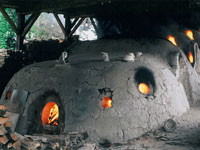Mashiko Ware: Characteristics
Mashiko Ware centers on the concept of “Functional Beauty”

It is said that Mashiko Ware began at the end of the Edo Era when Keisaburo Otsuka, who trained in Kasama, built a kiln. From that point onwards, because of the area’s yield of excellent kaolin and the fact that the large metropolis of Tokyo was nearby, Mashiko developed into a production area of pots, urns and water jars and other daily use items.
In 1924, Shoji Hamada moved into this region, and together with artists like Muneyoshi Yanagi, who paid attention to “Functional Beauty”, pushed the folk arts movement forward. He was also greatly influenced by the local artisans and took the side that Mashiko Ware was “works of art”.
Currently, there are 380 pottery studios and 50 pottery stores in Mashiko. There are many ceramicists, from young novices to veterans, who have built kilns here, and employ a diversity of styles. In spring and fall, pottery towns open up to many admirers of ceramics.
Article by Mashiko Town Tourist Association
